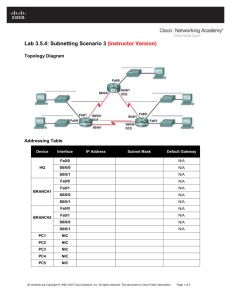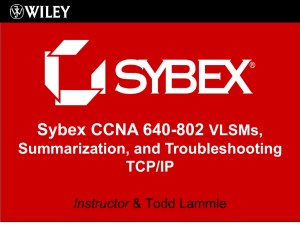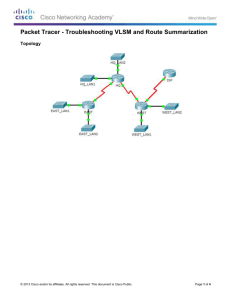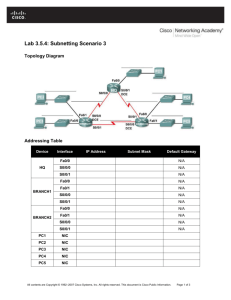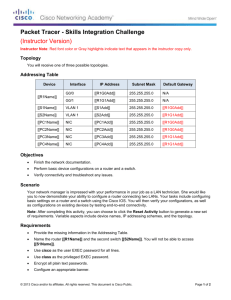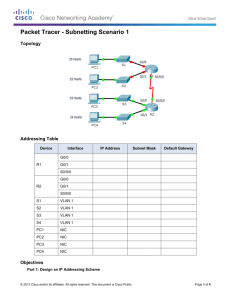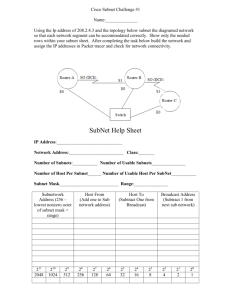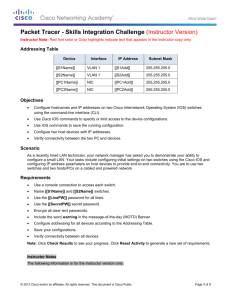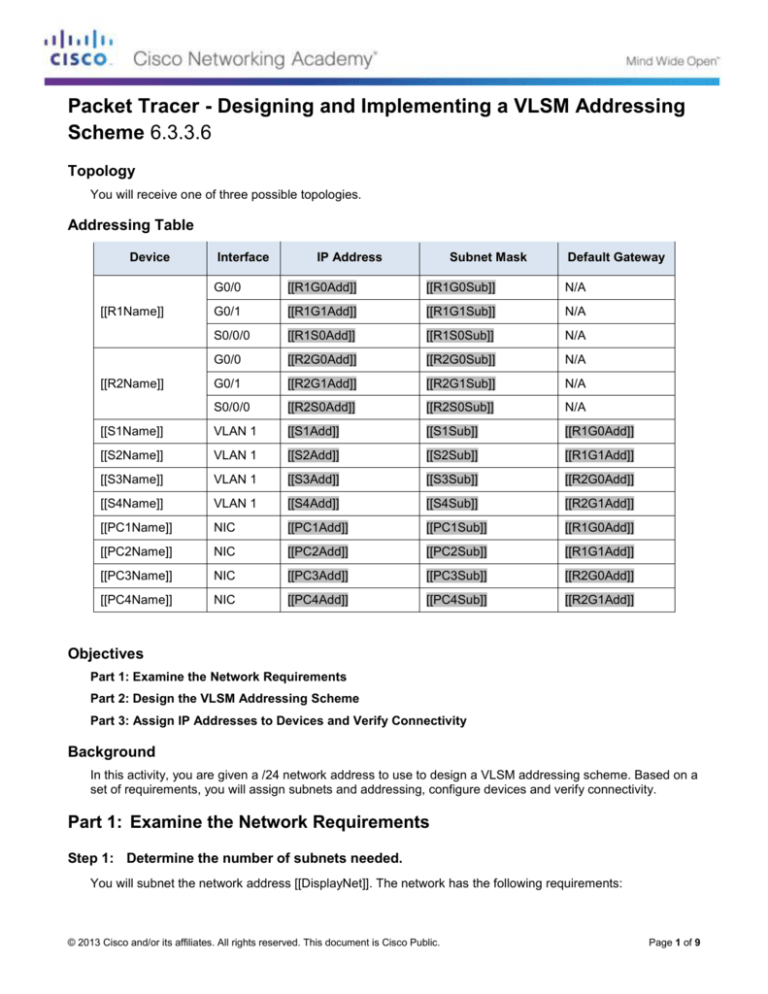
Packet Tracer - Designing and Implementing a VLSM Addressing
Scheme 6.3.3.6
Topology
You will receive one of three possible topologies.
Addressing Table
Device
Interface
IP Address
Subnet Mask
Default Gateway
G0/0
[[R1G0Add]]
[[R1G0Sub]]
N/A
G0/1
[[R1G1Add]]
[[R1G1Sub]]
N/A
S0/0/0
[[R1S0Add]]
[[R1S0Sub]]
N/A
G0/0
[[R2G0Add]]
[[R2G0Sub]]
N/A
G0/1
[[R2G1Add]]
[[R2G1Sub]]
N/A
S0/0/0
[[R2S0Add]]
[[R2S0Sub]]
N/A
[[S1Name]]
VLAN 1
[[S1Add]]
[[S1Sub]]
[[R1G0Add]]
[[S2Name]]
VLAN 1
[[S2Add]]
[[S2Sub]]
[[R1G1Add]]
[[S3Name]]
VLAN 1
[[S3Add]]
[[S3Sub]]
[[R2G0Add]]
[[S4Name]]
VLAN 1
[[S4Add]]
[[S4Sub]]
[[R2G1Add]]
[[PC1Name]]
NIC
[[PC1Add]]
[[PC1Sub]]
[[R1G0Add]]
[[PC2Name]]
NIC
[[PC2Add]]
[[PC2Sub]]
[[R1G1Add]]
[[PC3Name]]
NIC
[[PC3Add]]
[[PC3Sub]]
[[R2G0Add]]
[[PC4Name]]
NIC
[[PC4Add]]
[[PC4Sub]]
[[R2G1Add]]
[[R1Name]]
[[R2Name]]
Objectives
Part 1: Examine the Network Requirements
Part 2: Design the VLSM Addressing Scheme
Part 3: Assign IP Addresses to Devices and Verify Connectivity
Background
In this activity, you are given a /24 network address to use to design a VLSM addressing scheme. Based on a
set of requirements, you will assign subnets and addressing, configure devices and verify connectivity.
Part 1: Examine the Network Requirements
Step 1: Determine the number of subnets needed.
You will subnet the network address [[DisplayNet]]. The network has the following requirements:
© 2013 Cisco and/or its affiliates. All rights reserved. This document is Cisco Public.
Page 1 of 9
Packet Tracer - Designing and Implementing a VLSM Addressing Scheme
[[S1Name]] LAN will require [[HostReg1]] host IP addresses
[[S2Name]] LAN will require [[HostReg2]] host IP addresses
[[S3Name]] LAN will require [[HostReg3]] host IP addresses
[[S4Name]] LAN will require [[HostReg4]] host IP addresses
How many subnets are needed in the network topology? 5
Step 2: Determine the subnet mask information for each subnet.
a. Which subnet mask will accommodate the number of IP addresses required for [[S1Name]]?
How many usable host addresses will this subnet support?
b. Which subnet mask will accommodate the number of IP addresses required for [[S2Name]]?
How many usable host addresses will this subnet support?
c.
Which subnet mask will accommodate the number of IP addresses required for [[S3Name]]?
How many usable host addresses will this subnet support?
d. Which subnet mask will accommodate the number of IP addresses required for [[S4Name]]?
How many usable host addresses will this subnet support?
e. Which subnet mask will accommodate the number of IP addresses required for the connection between
[[R1Name]] and [[R2Name]]?
Part 2: Design the VLSM Addressing Scheme
Step 1: Divide the [[DisplayNet]] network based on the number of hosts per subnet.
a. Use the first subnet to accommodate the largest LAN.
b. Use the second subnet to accommodate the second largest LAN.
c.
Use the third subnet to accommodate the third largest LAN.
d. Use the fourth subnet to accommodate the fourth largest LAN.
e. Use the fifth subnet to accommodate the connection between [[R1Name]] and [[R2Name]].
Step 2: Document the VLSM subnets.
Complete the Subnet Table, listing the subnet descriptions (e.g. [[S1Name]] LAN), number of hosts needed,
then network address for the subnet, the first usable host address, and the broadcast address. Repeat until all
addresses are listed.
Subnet Table
Note: The correct answers for this table are variable depending on the scenario received. Refer to the
Instructor Notes at the end of these instructions for further information. The format here follows what the
student used in Designing and Implementing a VLSM Addressing Scheme.
© 2013 Cisco and/or its affiliates. All rights reserved. This document is Cisco Public.
Page 2 of 9
Packet Tracer - Designing and Implementing a VLSM Addressing Scheme
Subnet
Description
Number of
Hosts
Needed
Network
Address/CIDR
First Usable
Host Address
Broadcast
Address
Step 3: Document the addressing scheme.
a. Assign the first usable IP addresses to [[R1Name]] for the two LAN links and the WAN link.
b. Assign the first usable IP addresses to [[R2Name]] for the two LANs links. Assign the last usable IP
address for the WAN link.
c.
Assign the second usable IP addresses to the switches.
d. Assign the last usable IP addresses to the hosts.
Part 3: Assign IP Addresses to Devices and Verify Connectivity
Most of the IP addressing is already configured on this network. Implement the following steps to complete
the addressing configuration.
Step 1: Configure IP addressing on [[R1Name]] LAN interfaces.
Step 2: Configure IP addressing on [[S3Name]], including the default gateway.
Step 3: Configure IP addressing on [[PC4Name]], including the default gateway.
Step 4: Verify connectivity.
You can only verify connectivity from [[R1Name]], [[S3Name]], and [[PC4Name]]. However, you should be
able to ping every IP address listed in the Addressing Table.
Suggested Scoring Rubric
Note: The majority of points are allocated to designing and documenting the addressing scheme. Implementation
of the addresses in Packet Tracer is of minimal consideration.
© 2013 Cisco and/or its affiliates. All rights reserved. This document is Cisco Public.
Page 3 of 9
Packet Tracer - Designing and Implementing a VLSM Addressing Scheme
Activity Section
Part 1: Examine the
Network Requirements
Question
Location
Possible
Points
Step 1
1
Step 2
4
Part 1 Total
Earned
Points
5
Part 2: Design the VLSM Addressing Scheme
Complete Subnet Table
25
Document Addressing
40
Part 2 Total
65
Packet Tracer Score
30
Total Score
100
ID:[[indexAdds]][[indexNames]][[indexTopos]]
Instructor Notes:
The following addressing tables represent the three possible addressing scenarios the student may get. Note that
the Device column is independent of the addressing scheme. For example, a student could receive the device
names from Scenario 1 and the addressing scheme from Scenario 3. In addition, the three possible topologies
are also independent of the device names and the addressing scheme (click reset in the activity to see the
different topologies). Therefore, this activity uses three independent variables with three possible values each for
a total of 27 possible combinations (3 device names x 3 addressing schemes x 3 topologies = 27 isomorphs).
Scenario 1 - Network Address: 10.11.48.0/24
Subnet Table
Number of
Hosts
Needed
Subnet
Description
Network
Address/CIDR
First Usable
Host Address
Last Usable
Host Address
Broadcast
Address
Host-D LAN
60
10.11.48.0/26
10.11.48.1
10.11.48.62
10.11.48.63
Host-B LAN
30
10.11.48.64/27
10.11.48.65
10.11.48.94
10.11.48.95
Host-A LAN
14
10.11.48.96/28
10.11.48.97
10.11.48.110
10.11.48.111
Host-C LAN
6
10.11.48.112/29
10.11.48.113
10.11.48.118
10.11.48.119
WAN Link
2
10.11.48.120/30
10.11.48.121
10.11.48.122
10.11.48.123
© 2013 Cisco and/or its affiliates. All rights reserved. This document is Cisco Public.
Page 4 of 9
Packet Tracer - Designing and Implementing a VLSM Addressing Scheme
Device
Interface
Address
Subnet Mask
Default Gateway
G0/0
10.11.48.97
255.255.255.240
N/A
G0/1
10.11.48.65
255.255.255.224
N/A
S0/0/0
10.11.48.121
255.255.255.252
N/A
G0/0
10.11.48.113
255.255.255.248
N/A
G0/1
10.11.48.1
255.255.255.192
N/A
Building2
S0/0/0
10.11.48.122
255.255.255.252
N/A
ASW1
VLAN 1
10.11.48.98
255.255.255.240
10.11.48.97
ASW2
VLAN 1
10.11.48.66
255.255.255.224
10.11.48.65
ASW3
VLAN 1
10.11.48.114
255.255.255.248
10.11.48.113
ASW4
VLAN 1
10.11.48.2
255.255.255.192
10.11.48.1
Host-A
NIC
10.11.48.110
255.255.255.240
10.11.48.97
Host-B
NIC
10.11.48.94
255.255.255.224
10.11.48.65
Host-C
NIC
10.11.48.118
255.255.255.248
10.11.48.113
Host-D
NIC
10.11.48.62
255.255.255.192
10.11.48.1
Building1
Building 1
en
conf t
int g0/0
ip add 10.11.48.97 255.255.255.240
no shut
int g0/1
ip add 10.11.48.65 255.255.255.224
no shut
ASW3
en
conf t
int vlan 1
ip add 10.11.48.114 255.255.255.248
no shut
ip def 10.11.48.113
© 2013 Cisco and/or its affiliates. All rights reserved. This document is Cisco Public.
Page 5 of 9
Packet Tracer - Designing and Implementing a VLSM Addressing Scheme
Scenario 2 - Network Address: 172.31.103.0/24
Subnet Table
Number of
Hosts
Needed
Subnet
Description
Network
Address/CIDR
First Usable
Host Address
Last Usable
Host Address
Broadcast
Address
PC-A LAN
27
172.31.103.0/27
172.31.103.1
172.31.103.30
172.31.103.31
PC-B LAN
25
172.31.103.32/27
172.31.103.33
172.31.103.62
172.31.103.63
PC-C LAN
14
172.31.103.64/28
172.31.103.65
172.31.103.78
172.31.103.79
PC-D LAN
8
172.31.103.80/28
172.31.103.81
172.31.103.94
172.31.103.95
WAN Link
2
172.31.103.96/30
172.31.103.97
172.31.103.98
172.31.103.99
Device
Interface
Address
Subnet Mask
Default Gateway
G0/0
172.31.103.1
255.255.255.224
N/A
G0/1
172.31.103.33
255.255.255.224
N/A
S0/0/0
172.31.103.97
255.255.255.252
N/A
G0/0
172.31.103.65
255.255.255.240
N/A
G0/1
172.31.103.81
255.255.255.240
N/A
Branch2
S0/0/0
172.31.103.98
255.255.255.252
N/A
Room-114
VLAN 1
172.31.103.2
255.255.255.224
172.31.103.1
Room-279
VLAN 1
172.31.103.34
255.255.255.224
172.31.103.33
Room-312
VLAN 1
172.31.103.66
255.255.255.240
172.31.103.65
Room-407
VLAN 1
172.31.103.82
255.255.255.240
172.31.103.81
PC-A
NIC
172.31.103.30
255.255.255.224
172.31.103.1
PC-B
NIC
172.31.103.62
255.255.255.224
172.31.103.33
PC-C
NIC
172.31.103.78
255.255.255.240
172.31.103.65
PC-D
NIC
172.31.103.94
255.255.255.240
172.31.103.81
Branch1
Branch 1
en
conf t
int g0/0
ip add 172.31.103.1 255.255.255.224
no shut
int g0/1
© 2013 Cisco and/or its affiliates. All rights reserved. This document is Cisco Public.
Page 6 of 9
Packet Tracer - Designing and Implementing a VLSM Addressing Scheme
ip add 172.31.103.33 255.255.255.224
no shut
Room-312
en
conf t
int vlan 1
ip add 172.31.103.66 255.255.255.240
no shut
ip def 172.31.103.65
© 2013 Cisco and/or its affiliates. All rights reserved. This document is Cisco Public.
Page 7 of 9
Packet Tracer - Designing and Implementing a VLSM Addressing Scheme
Scenario 3 - Network Address: 192.168.72.0/24
Subnet Table
Number of
Hosts
Needed
Subnet
Description
Network
Address/CIDR
First Usable
Host Address
Last Usable
Host Address
Broadcast
Address
User-4 LAN
58
192.168.72.0/26
192.168.72.1
192.168.72.62
192.168.72.63
User-3 LAN
29
192.168.72.64/27
192.168.72.65
192.168.72.94
192.168.72.95
User-2 LAN
15
192.168.72.96/27
192.168.72.97
192.168.72.126
192.168.72.127
User-1 LAN
7
192.168.72.128/28
192.168.72.129
192.168.72.142
192.168.72.143
WAN Link
2
192.168.72.144/30
192.168.72.145
192.168.72.146
192.168.72.147
Device
Interface
Address
Subnet Mask
Default Gateway
G0/0
192.168.72.129
255.255.255.240
N/A
G0/1
192.168.72.97
255.255.255.224
N/A
S0/0/0
192.168.72.145
255.255.255.252
N/A
G0/0
192.168.72.65
255.255.255.224
N/A
G0/1
192.168.72.1
255.255.255.192
N/A
Remote-Site2
S0/0/0
192.168.72.146
255.255.255.252
N/A
Sw1
VLAN 1
192.168.72.130
255.255.255.240
192.168.72.129
Sw2
VLAN 1
192.168.72.98
255.255.255.224
192.168.72.97
Sw3
VLAN 1
192.168.72.66
255.255.255.224
192.168.72.65
Sw4
VLAN 1
192.168.72.2
255.255.255.192
192.168.72.1
User-1
NIC
192.168.72.142
255.255.255.240
192.168.72.129
User-2
NIC
192.168.72.126
255.255.255.224
192.168.72.97
User-3
NIC
192.168.72.94
255.255.255.224
192.168.72.65
User-4
NIC
192.168.72.62
255.255.255.192
192.168.72.1
Remote-Site1
Remote-Site1
en
conf t
int g0/0
ip add 192.168.72.129 255.255.255.240
no shut
int g0/1
© 2013 Cisco and/or its affiliates. All rights reserved. This document is Cisco Public.
Page 8 of 9
Packet Tracer - Designing and Implementing a VLSM Addressing Scheme
ip add 192.168.72.97 255.255.255.224
no shut
Sw-3
en
conf t
int vlan 1
ip add 192.168.72.66 255.255.255.224
no shut
ip def 192.168.72.65
© 2013 Cisco and/or its affiliates. All rights reserved. This document is Cisco Public.
Page 9 of 9


